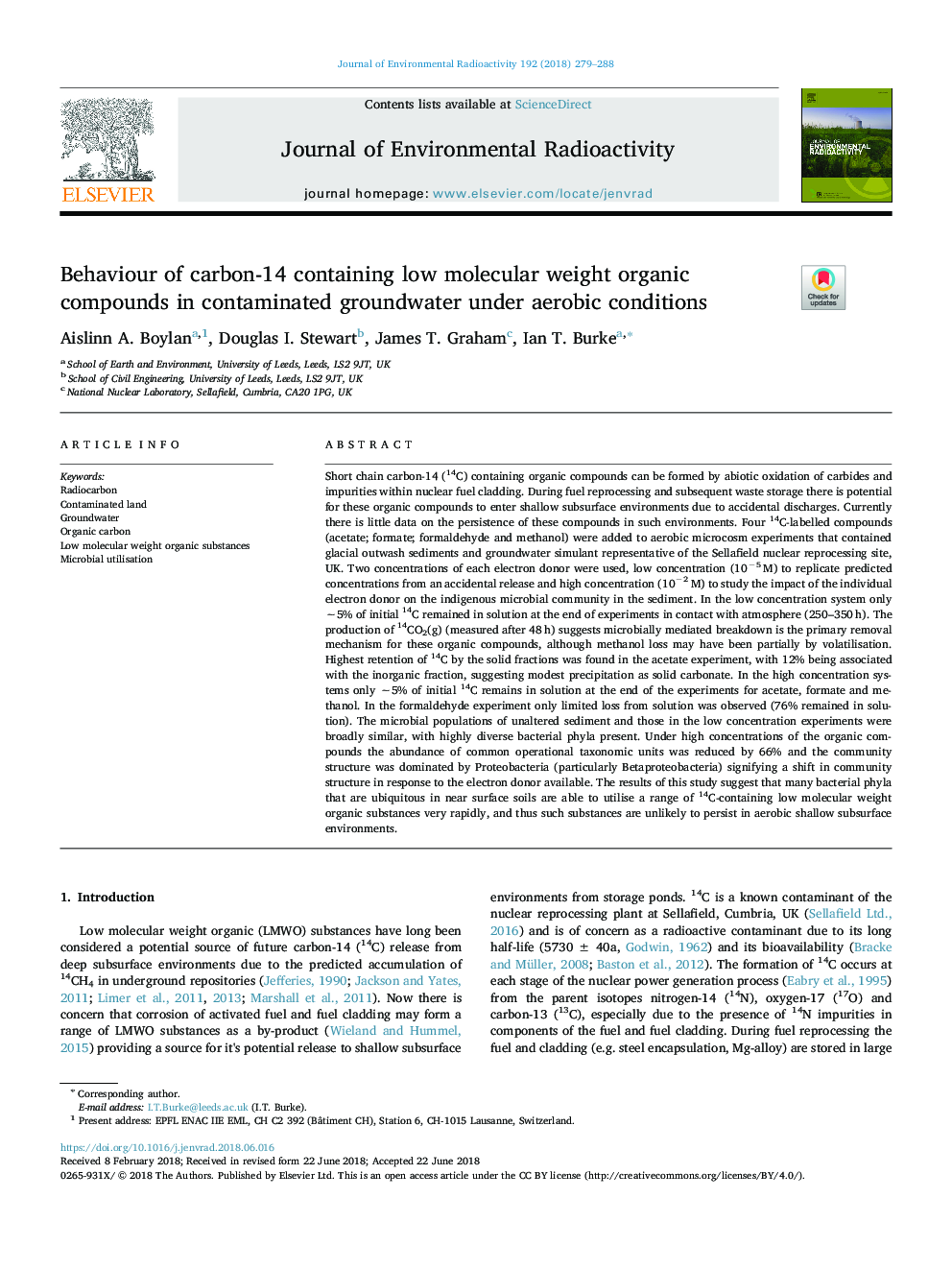| کد مقاله | کد نشریه | سال انتشار | مقاله انگلیسی | نسخه تمام متن |
|---|---|---|---|---|
| 8080242 | 1521551 | 2018 | 10 صفحه PDF | دانلود رایگان |
عنوان انگلیسی مقاله ISI
Behaviour of carbon-14 containing low molecular weight organic compounds in contaminated groundwater under aerobic conditions
ترجمه فارسی عنوان
رفتار کربن -14 حاوی ترکیبات آلی کم وزن مولکولی در آب های زیرزمینی آلوده در شرایط هوازی
دانلود مقاله + سفارش ترجمه
دانلود مقاله ISI انگلیسی
رایگان برای ایرانیان
کلمات کلیدی
رادیو کربن، زمین آلوده، آب های زیرزمینی، کربن ارگانیک، مواد آلی کم وزن مولکولی، استفاده از میکروبی،
موضوعات مرتبط
مهندسی و علوم پایه
مهندسی انرژی
انرژی هسته ای و مهندسی
چکیده انگلیسی
Short chain carbon-14 (14C) containing organic compounds can be formed by abiotic oxidation of carbides and impurities within nuclear fuel cladding. During fuel reprocessing and subsequent waste storage there is potential for these organic compounds to enter shallow subsurface environments due to accidental discharges. Currently there is little data on the persistence of these compounds in such environments. Four 14C-labelled compounds (acetate; formate; formaldehyde and methanol) were added to aerobic microcosm experiments that contained glacial outwash sediments and groundwater simulant representative of the Sellafield nuclear reprocessing site, UK. Two concentrations of each electron donor were used, low concentration (10â5â¯M) to replicate predicted concentrations from an accidental release and high concentration (10â2â¯M) to study the impact of the individual electron donor on the indigenous microbial community in the sediment. In the low concentration system only â¼5% of initial 14C remained in solution at the end of experiments in contact with atmosphere (250-350â¯h). The production of 14CO2(g) (measured after 48â¯h) suggests microbially mediated breakdown is the primary removal mechanism for these organic compounds, although methanol loss may have been partially by volatilisation. Highest retention of 14C by the solid fractions was found in the acetate experiment, with 12% being associated with the inorganic fraction, suggesting modest precipitation as solid carbonate. In the high concentration systems only â¼5% of initial 14C remains in solution at the end of the experiments for acetate, formate and methanol. In the formaldehyde experiment only limited loss from solution was observed (76% remained in solution). The microbial populations of unaltered sediment and those in the low concentration experiments were broadly similar, with highly diverse bacterial phyla present. Under high concentrations of the organic compounds the abundance of common operational taxonomic units was reduced by 66% and the community structure was dominated by Proteobacteria (particularly Betaproteobacteria) signifying a shift in community structure in response to the electron donor available. The results of this study suggest that many bacterial phyla that are ubiquitous in near surface soils are able to utilise a range of 14C-containing low molecular weight organic substances very rapidly, and thus such substances are unlikely to persist in aerobic shallow subsurface environments.
ناشر
Database: Elsevier - ScienceDirect (ساینس دایرکت)
Journal: Journal of Environmental Radioactivity - Volume 192, December 2018, Pages 279-288
Journal: Journal of Environmental Radioactivity - Volume 192, December 2018, Pages 279-288
نویسندگان
Aislinn A. Boylan, Douglas I. Stewart, James T. Graham, Ian T. Burke,
